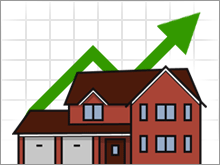|
Stuck! Homes sit longer on the market It's taking longer to sell a house these days. Is this another sign that the boom is over? NEW YORK (CNNMoney.com) -- The tell-tale sign of a stagnating real estate market? When homes for sale start lingering - and that's exactly what real estate brokers and other industry watchers say they're seeing now. The National Association of Realtors does not maintain national time-on-market figures. But inventory - the number of homes for sale - spiked 37 percent for the 12 months through April 30, the most recent data available.
At the same time, the rate of sales has slowed, so that there is now 6 months worth of supply, up from 4.1 months a year earlier. All that supply means homes are sitting around longer and that sellers are asking more than buyers are willing to pay -- an indication that prices may have to come down. "Sellers are in denial, and there is a rising disconnect with the buyers," said Jonathan Miller, a real estate appraiser in New York. "Until sellers get the message, you'll see a drop in the number of transactions." Philadelphia has seen only a modest run-up in time-on-market from about 23 days last year to a still low 33 today. But the city's inventory has grown from nearly 21,000 last year to more than 36,000 today, a more than 50-percent jump. "The sales pace is identical, but inventory is way up," says Harry Caparo, who runs Coldwell Banker Preferred in Philadelphia. "Time-on-market is going to start to rise." Two markets The cool or steady markets seem to be maintaining their equilibrium. David Barnes, a broker in Nashville, Tennessee, says time-on-market there has risen modestly this year to around 75 days from 65 days. Carolyn Heimlinger, a broker in Des Moines, says the figure there is about 82 days, up from 75 days a year ago. Prices have flattened but not dropped. "Where I see concessions is new constructions," says Heimlinger. "Developers now offer rebates and free upgrades." In Charlotte, N.C., Wallace Perry, president of Coldwell Banker United for the area, says time-on-market hasn't changed much, at 85 days to 90 days. "It's a very good sign that the market here is holding steady." But in once superheated markets, things have gotten tougher. In Hanover, New Hampshire, broker Ned Redpath reports a "drastic" increase in time-on-market. All through the 2000s, New Hampshire averaged double-digit price increases and about 60 to 70 days on market. Now Redpath estimates average time-on-market at 125 days. He expects price changes to soon reflect that. "The longer a listing is on the market," he says, "the more the price will come down." In once white-hot Napa, California, Coldwell Banker broker Doug Fowler reports an increase to between 60 days and 90 days, where they once were a week or two. He thinks the long-term prospects for Napa are fine, but the area could see short-term adjustments. Boston time-on-market has gone from 52 to 58 days, according to Susan Hsu, a RE/MAX broker. In Phoenix, according to Valley Wide Homes broker Ron Wilczek, time on the market was often less than a week in 2005. Now it's approaching 60 days. And in Miami, the time-on-market has lengthened to between 30 and 40 days from about 20 just a few weeks ago, according to Mario Tome, of Greater Miami Realty. All this is evidence that the real estate boom may have run its course in many hot markets. At the very least, sellers will have to set their prices very carefully if they want to move their properties quickly and avoid long months of having their houses spending time-on-market. ____________________________________
|
|

